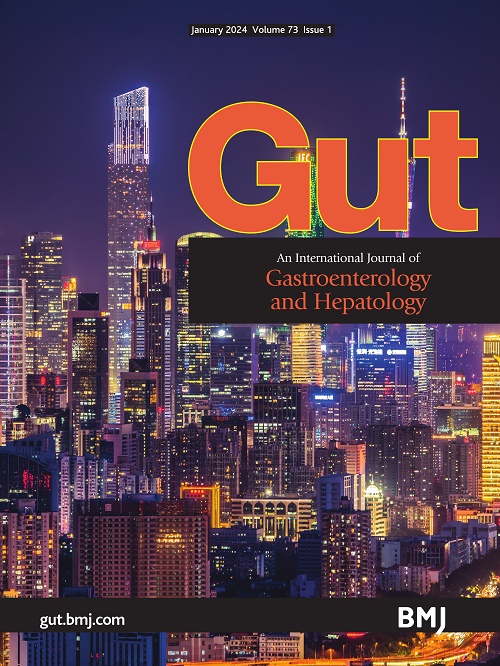Longitudinal paired liver biopsies and transcriptome profiling in alcohol-associated hepatitis reveal dynamic changes in cellular senescence
IF 23
1区 医学
Q1 GASTROENTEROLOGY & HEPATOLOGY
引用次数: 0
Abstract
Background and aims Alcohol-associated hepatitis (AH) is an acute form of alcohol-related liver disease (ALD) with high mortality rate. AH is histologically characterised by cellular processes, including steatosis, inflammation and cell death. Apoptosis is the most studied form of cell death in AH; however, the role of cellular senescence, another response to cellular injury, in AH is unknown. Here, we explore the mechanisms of ALD pathophysiology and describe the role of senescence in AH. Methods We performed RNA sequencing and bioinformatics analysis of 0- and 28-day transjugular liver biopsies (n=65) from patients with AH participating in the IL-1 Signal Inhibition In Alcoholic Hepatitis (ISAIAH) clinical trial. Additional bioinformatics reanalysis of existing AH transcriptomic datasets was conducted to confirm our findings. We also performed multiomic analysis of an in vitro model of AH with ethanol-treated hepatocytes overexpressing ethanol-metabolising enzymes. Results Our longitudinal analysis revealed that senescence and inflammation were reduced at transcriptomic level following AH resolution; the expression of hepatocyte markers was increased. We identified two senescence-associated protein complexes, cytochrome c oxidase and the proteasome, which may act as senescence-induction mechanisms. We confirmed that senescence markers and pathways were increasingly expressed in hepatocytes as ALD progressed towards AH; this was partially reversed following AH resolution. Our in vitro model revealed that ethanol directly induces senescence and was dependent on ethanol metabolism. Conclusions Our results suggest a possible pathogenic role for senescence in AH and indicate cellular senescence as a potential therapeutic target in early ALD to limit AH severity. Data are available in a public, open-access repository. Data are available in public, open-access repositories. The RNA-seq data generated in this study have been deposited in NCBI GEO (背景和目的 酒精相关性肝炎(AH)是一种急性酒精相关性肝病(ALD),死亡率很高。酒精相关性肝炎的组织学特征是细胞过程,包括脂肪变性、炎症和细胞死亡。细胞凋亡是研究最多的酒精相关性肝病细胞死亡形式;然而,细胞衰老作为细胞损伤的另一种反应,在酒精相关性肝病中的作用尚不清楚。在此,我们探讨了 ALD 的病理生理学机制,并描述了衰老在 AH 中的作用。方法 我们对参加 IL-1 信号抑制酒精性肝炎(ISAIAH)临床试验的 AH 患者(n=65)的 0 天和 28 天经颈静脉肝活检组织进行了 RNA 测序和生物信息学分析。我们还对现有的 AH 转录组数据集进行了生物信息学再分析,以证实我们的发现。我们还利用乙醇处理过的肝细胞过表达乙醇代谢酶对 AH 体外模型进行了多组学分析。结果 我们的纵向分析表明,AH 解体后,衰老和炎症在转录组水平上减少了;肝细胞标志物的表达增加了。我们发现了两种衰老相关蛋白复合物,即细胞色素 c 氧化酶和蛋白酶体,它们可能是衰老诱导机制。我们证实,随着 ALD 向 AH 发展,衰老标记物和衰老途径在肝细胞中的表达量不断增加;AH 解除后,这种情况得到部分逆转。我们的体外模型显示,乙醇可直接诱导衰老,并且依赖于乙醇代谢。结论 我们的研究结果表明衰老在 AH 中可能起致病作用,并表明细胞衰老是 ALD 早期的潜在治疗靶点,可限制 AH 的严重程度。数据可在公开、开放的资源库中获取。数据可在公开、开放存取的资源库中获取。本研究产生的 RNA-seq 数据已存入 NCBI GEO()(超级系列 GSE270043)。质谱蛋白质组学数据已通过 PRIDE 合作伙伴资源库存入 ProteomeXchange Consortium(),数据集标识符为 PXD053109。
本文章由计算机程序翻译,如有差异,请以英文原文为准。
求助全文
约1分钟内获得全文
求助全文
来源期刊

Gut
医学-胃肠肝病学
CiteScore
45.70
自引率
2.40%
发文量
284
审稿时长
1.5 months
期刊介绍:
Gut is a renowned international journal specializing in gastroenterology and hepatology, known for its high-quality clinical research covering the alimentary tract, liver, biliary tree, and pancreas. It offers authoritative and current coverage across all aspects of gastroenterology and hepatology, featuring articles on emerging disease mechanisms and innovative diagnostic and therapeutic approaches authored by leading experts.
As the flagship journal of BMJ's gastroenterology portfolio, Gut is accompanied by two companion journals: Frontline Gastroenterology, focusing on education and practice-oriented papers, and BMJ Open Gastroenterology for open access original research.
 求助内容:
求助内容: 应助结果提醒方式:
应助结果提醒方式:


